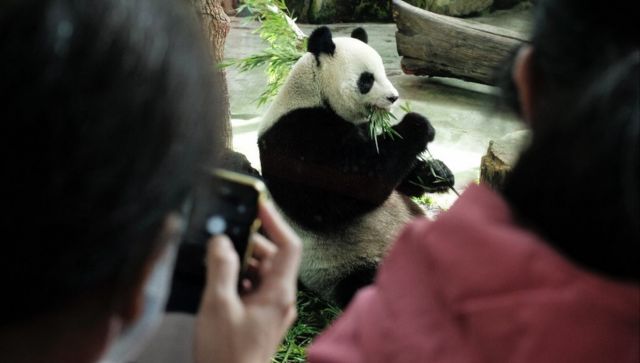In 1972, two pandas were welcomed to the Washington zoo by thousands of people. The furballs were a gift from Beijing after then US president Richard Nixon’s landmark trip to China. Now, over 50 years later, China is taking back its pandas from the United States. But what is happening? And why is this happening? Let’s take a closer look: What is happening? The Washington zoo will send back all three of its pandas to China by the end of the year. The development brings an end to a decades-long relationship between the adorable species and the US capital. The zoo has begun a week-long “Panda Palooza” event in preparation for the departure, inviting hundreds of admirers, many of whom are dressed in panda-themed caps and shirts. Jane Christensen was eager to visit the giant pandas before they departed Washington, no matter the distance or the weather. Christensen, now in her 60s, told AFP that she was captivated by the species’ mystical sweetness more than a half-century ago when China initially sent two pandas to the United States. “I’ve had ‘panda-monium’ ever since,’ she said under a chilly rain outside the Smithsonian National Zoo’s panda exhibit – hundreds of miles from her home in Michigan. Panda diplomacy China, recognising the species’ uncanny ability to attract fans — and a potential source of income for its conservation program — has since China continued to loan out pandas to Washington and other zoos around the world. Experts say the scheme, since labelled “Panda Diplomacy,” is a classic example of soft power. [caption id=“attachment_12445342” align=“alignnone” width=“640”] 22-year-old Ya Ya had come to the US in 2003 along with Le Le, a male panda who died in February. AP[/caption] “It’s soft power,” Andrew J Nathan, a political science professor at Columbia who specialises in Chinese politics and foreign policy, told The New York Times. “Pandas are very cute and lovable, so it fits into that kind of friendship diplomacy image,” he added. As per the report, the bears also serve as Beijing’s “goodwill ambassadors” and soften its authoritarian image.
22-year-old Ya Ya had come to the US in 2003 along with Le Le, a male panda who died in February. AP[/caption] “It’s soft power,” Andrew J Nathan, a political science professor at Columbia who specialises in Chinese politics and foreign policy, told The New York Times. “Pandas are very cute and lovable, so it fits into that kind of friendship diplomacy image,” he added. As per the report, the bears also serve as Beijing’s “goodwill ambassadors” and soften its authoritarian image.
Assistant professor Benjamin Ho told CNA that soft power is a ‘non-coercive’ means of influence.
Ho, who coordinates the China programme at the S. Rajaratnam School of International Studies (RSIS) think-tank, added, “Panda diplomacy represents just one of the many tools of diplomacy China has at its disposal.” As per CNA, the practice of gifting animals to major powers goes back as far as the 7th Century. Empress Wu Zeitan sent Japan two bears, as per a Doha News report. The People’s Republic of China (PRC) in 1957 under Mao Zedong brought the practice back when it gifted the panda ‘Ping Ping’ to the then Soviet Union ‘Ping Ping’ to strengthen relations. China gifted pandas to Russia and North Korea during the Cold War Beijing in 1974 began regularly loaning out pandas on 10-year loans after the species became endangered. Nations that want pandas must lease them from China. As per CNA, this can command a hefty tag – up to $1 million per year. Any cubs born during the loan period also immediately become property of Beijing. China has loaned out around 60 giant pandas to 18 nations including France, the UK, Germany, and Mexico. Alan Chong, a soft power expert and senior fellow at RSIS said the animals “serve as an index as well as a vehicle for promoting good relations between China and the recipient country.” A piece in The Times of India noted that pandas are usually ‘gifted’ to a nation around the same time as important trade deals are signed. Conversely, Beijing can also recall a panda to indicate its displeasure – as it did in 2010 when then president Barack Obama met the Dalai Lama. Why is this happening? The move comes amid growing tension between Washington and China over Taiwan and lingering trade disputes. In 2000, pandas Mei Xiang and Tian Tian arrived in Washington. [caption id=“attachment_12518742” align=“alignnone” width=“640”] Following Ya Ya’s return, the US has only 10 giant pandas left. AP[/caption] They have since had four surviving cubs. Xiao Qi Ji (“Little Miracle” in English) was born in 2020 and will also depart by December. During Xi Jinping’s state visit in 2015, the last by a Chinese leader to the United States, his wife and the US first lady held an official ceremony to unveil the name of panda cub Bei Bei. Now, eight years later, the panda exhibit is slated to be closed. “The Chinese government tends to “bestow” pandas on “nations with whom China’s relations are on the upswing, as a form of soft power projection,” explained Kurt Tong, a former high-ranking US diplomat and managing partner of the Asia Group consultancy. “In that respect, given the current tenor of US-China relations it is not surprising that Chinese authorities are allowing panda contracts with US zoos to expire,” Tong said in an email to AFP. He noted that the loans also help China “augment the panda conservation budget.” Foreign zoos are also required to send older pandas on loan back to China to spend their final days. In April, a 22-year-old female giant panda named ‘Ya Ya’ was sent back from United States’ Memphis Zoo in Tennessee.
Following Ya Ya’s return, the US has only 10 giant pandas left. AP[/caption] They have since had four surviving cubs. Xiao Qi Ji (“Little Miracle” in English) was born in 2020 and will also depart by December. During Xi Jinping’s state visit in 2015, the last by a Chinese leader to the United States, his wife and the US first lady held an official ceremony to unveil the name of panda cub Bei Bei. Now, eight years later, the panda exhibit is slated to be closed. “The Chinese government tends to “bestow” pandas on “nations with whom China’s relations are on the upswing, as a form of soft power projection,” explained Kurt Tong, a former high-ranking US diplomat and managing partner of the Asia Group consultancy. “In that respect, given the current tenor of US-China relations it is not surprising that Chinese authorities are allowing panda contracts with US zoos to expire,” Tong said in an email to AFP. He noted that the loans also help China “augment the panda conservation budget.” Foreign zoos are also required to send older pandas on loan back to China to spend their final days. In April, a 22-year-old female giant panda named ‘Ya Ya’ was sent back from United States’ Memphis Zoo in Tennessee.
As per Reuters, US zoos now have just 10 giant pandas left following the departure of Ya Ya.
Ya Ya’s return came as Memphis Zoo’s 20-year loan agreement for joint research and conservation projects with the Chinese Association of Zoological Gardens ended. It also came amid the backdrop of claims that the zoo was mistreating giant pandas. Meanwhile, Zoo Atlanta, in the southern US state of Georgia, will return its four pandas to China by late 2024. The pandas’ departure “closes a major chapter of an international animal care and conservation success story,” the zoo said in a statement, adding that it “remains committed to continuing its efforts to secure and safeguard a healthy future for giant pandas.” The Smithsonian pays $500,000 annually to its Chinese conservation group partner, the zoo said. One attendee saying her goodbyes at the zoo highlighted successful efforts to grow the wild population of pandas. “We’ve come a long way in getting the numbers back up,” said Michaela from Maryland, who had her face painted like a panda. The species remains listed as vulnerable. As the rain let up, a steady stream of visitors began filling the area around the panda’s outdoor enclosure. Known for being a bit sluggish, the panda made repeated laps around the acre-sized plot, climbing up and down the hills — making sure everyone got one good, final snapshot. With inputs from agencies
)